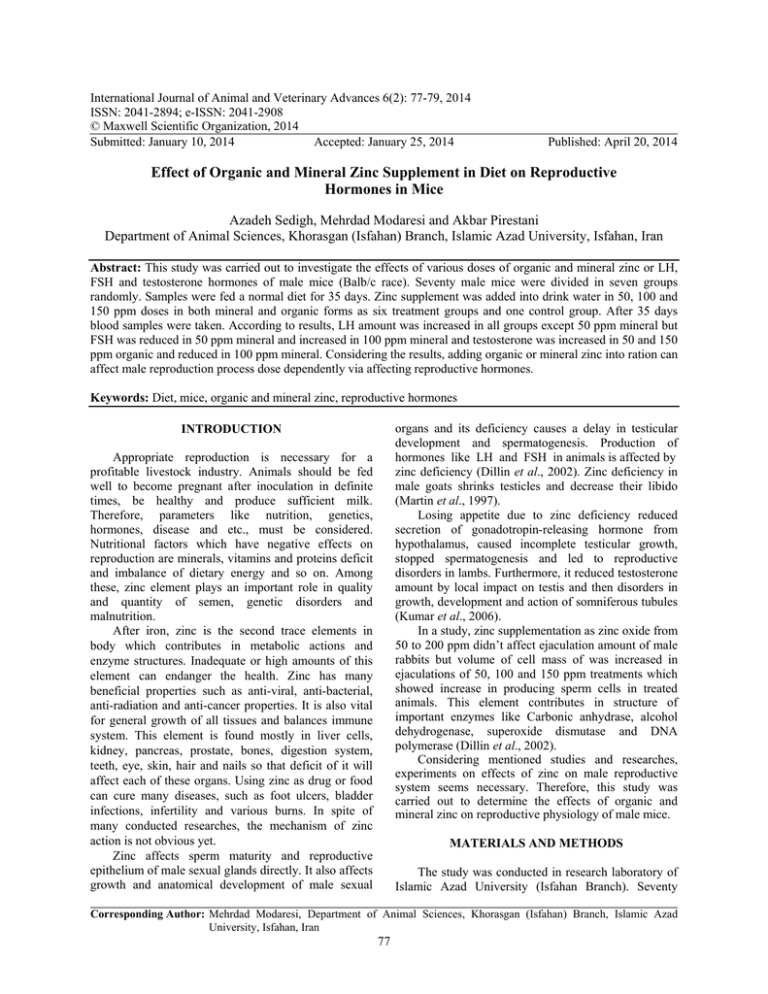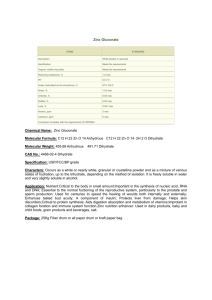International Journal of Animal and Veterinary Advances 6(2): 77-79, 2014
advertisement

International Journal of Animal and Veterinary Advances 6(2): 77-79, 2014 ISSN: 2041-2894; e-ISSN: 2041-2908 © Maxwell Scientific Organization, 2014 Submitted: January 10, 2014 Accepted: January 25, 2014 Published: April 20, 2014 Effect of Organic and Mineral Zinc Supplement in Diet on Reproductive Hormones in Mice Azadeh Sedigh, Mehrdad Modaresi and Akbar Pirestani Department of Animal Sciences, Khorasgan (Isfahan) Branch, Islamic Azad University, Isfahan, Iran Abstract: This study was carried out to investigate the effects of various doses of organic and mineral zinc or LH, FSH and testosterone hormones of male mice (Balb/c race). Seventy male mice were divided in seven groups randomly. Samples were fed a normal diet for 35 days. Zinc supplement was added into drink water in 50, 100 and 150 ppm doses in both mineral and organic forms as six treatment groups and one control group. After 35 days blood samples were taken. According to results, LH amount was increased in all groups except 50 ppm mineral but FSH was reduced in 50 ppm mineral and increased in 100 ppm mineral and testosterone was increased in 50 and 150 ppm organic and reduced in 100 ppm mineral. Considering the results, adding organic or mineral zinc into ration can affect male reproduction process dose dependently via affecting reproductive hormones. Keywords: Diet, mice, organic and mineral zinc, reproductive hormones organs and its deficiency causes a delay in testicular development and spermatogenesis. Production of hormones like LH and FSH in animals is affected by zinc deficiency (Dillin et al., 2002). Zinc deficiency in male goats shrinks testicles and decrease their libido (Martin et al., 1997). Losing appetite due to zinc deficiency reduced secretion of gonadotropin-releasing hormone from hypothalamus, caused incomplete testicular growth, stopped spermatogenesis and led to reproductive disorders in lambs. Furthermore, it reduced testosterone amount by local impact on testis and then disorders in growth, development and action of somniferous tubules (Kumar et al., 2006). In a study, zinc supplementation as zinc oxide from 50 to 200 ppm didn’t affect ejaculation amount of male rabbits but volume of cell mass of was increased in ejaculations of 50, 100 and 150 ppm treatments which showed increase in producing sperm cells in treated animals. This element contributes in structure of important enzymes like Carbonic anhydrase, alcohol dehydrogenase, superoxide dismutase and DNA polymerase (Dillin et al., 2002). Considering mentioned studies and researches, experiments on effects of zinc on male reproductive system seems necessary. Therefore, this study was carried out to determine the effects of organic and mineral zinc on reproductive physiology of male mice. INTRODUCTION Appropriate reproduction is necessary for a profitable livestock industry. Animals should be fed well to become pregnant after inoculation in definite times, be healthy and produce sufficient milk. Therefore, parameters like nutrition, genetics, hormones, disease and etc., must be considered. Nutritional factors which have negative effects on reproduction are minerals, vitamins and proteins deficit and imbalance of dietary energy and so on. Among these, zinc element plays an important role in quality and quantity of semen, genetic disorders and malnutrition. After iron, zinc is the second trace elements in body which contributes in metabolic actions and enzyme structures. Inadequate or high amounts of this element can endanger the health. Zinc has many beneficial properties such as anti-viral, anti-bacterial, anti-radiation and anti-cancer properties. It is also vital for general growth of all tissues and balances immune system. This element is found mostly in liver cells, kidney, pancreas, prostate, bones, digestion system, teeth, eye, skin, hair and nails so that deficit of it will affect each of these organs. Using zinc as drug or food can cure many diseases, such as foot ulcers, bladder infections, infertility and various burns. In spite of many conducted researches, the mechanism of zinc action is not obvious yet. Zinc affects sperm maturity and reproductive epithelium of male sexual glands directly. It also affects growth and anatomical development of male sexual MATERIALS AND METHODS The study was conducted in research laboratory of Islamic Azad University (Isfahan Branch). Seventy Corresponding Author: Mehrdad Modaresi, Department of Animal Sciences, Khorasgan (Isfahan) Branch, Islamic Azad University, Isfahan, Iran 77 Int. J. Anim. Veter. Adv., 6(2): 77-79, 2014 male mice from Balb/c race were kept for 35 days to adapt to environment. During this period samples had free access to normal light, water and normal diet. The study was done as completely randomized design with one control and six treatment groups (organic and mineral). Zinc was added to drink water in 50, 100 and 150 ppm doses. Groups 1 to 3 received 50 to 150 ppm mineral zinc whereas 4 to 6 groups received the same doses of organic zinc daily for 15 days. At the end of treatments, blood samples were taken to measure LH, FSH and testosterone hormones. Results were analyzed using one way ANOVA and means were compared using Duncan multiple ranges test at 5% probability level. Mean FSH (m/u/mL) 1.00 0.80 0.60 The mean different is significant at the 0.05 Error bars 95% CI * 0.65 0.63 0.42 0.55 0.55 0.50 * 0.37 0.40 0.20 rga nic 10 0o rga n ic 15 0o rga nic 50 mi ner al 100 mi ner al 15 0m ine ral 50 o Co n tr ol 0.00 Zinc (ppm) RESULTS Fig. 1: The concentration of FSH, LH and testosterone hormones in different groups According to results, FSH was increased significantly (p<0.05) in 100 ppm mineral group and reduced in 50 ppm mineral but was not changed in other groups. LH concentration of all groups except 50 ppm was increased significantly (p<0.05). Testosterone amount was increased in organic 50 and 150 ppm groups but reduced in mineral 100 ppm significantly (Fig. 1). DISCUSSION Spermatogenesis mechanism in testis is depending on harmonized action of hypothalamic-pituitarytesticular axis (Iammarrone et al., 2003). Local factors and sometimes immunological factors are very important here. Among these items, nutrition and supplements like zinc are from factors which can affect secretion process of reproductive hormones (Butler, 2003). Therefore, existence of zinc in ration can affect reproduction parameters. The gonadotropin releasing hormone from hypothalamus affects front pituitary and causes increase in secretion of LH, FSH and then simulates testosterone secretion (Mitra et al., 1996). FSH amount was increased in current study by 100 ppm mineral zinc which can play a positive role in spermatogenesis. Also, LH amount of all organic treatments and 100 and 150 ppm of mineral treatments were increased which is very important in releasing testosterone hormone. The amount of testosterone was increased also in 50 and 150 ppm doses of organic zinc which is effective in appearance of secondary sexual traits and reproduction activities. Simultaneous increase of FSH and LH in serum by 100 ppm mineral shows effect on hypothalamicpituitary-testicular axis. This can be because of increase in secretion amount of LH and FSH from front pituitary and following increase in testosterone level of serum (Sato and Tsukamoto, 2000). Therefore, increase in serum level of testosterone in 50 and 150 ppm doses of organic has been secondary result of gonad stimulating hormones especially LH. This axis can be affected by concentration controlling factors (negative and positive). Feedback effect of Inhibin is reduced by decrease in stem cells and spermatocyctes and then FSH will be increased. On the whole, we can announce that adding organic or mineral zinc can affect hormones of reproductive system dose dependently and thereby affects the process of spermatogenesis and fertility. Mean testosterone (mg/mL) The mean different is significant at the 0.05 Error bars 95% CI 1.00 0.69 * 0.80 0.60 0.34 0.59 * 0.43 0.42 0.37 0.40 0.19 * 0.20 Co ntr ol 50 org ani c 10 0o rga nic 15 0o rga nic 50 mi ner al 100 mi ner al 15 0m ine ral 0.00 Zinc (ppm) The mean different is significant at the 0.05 Error bars 95% CI * 0.49 * 0.47 0.50 * 0.50 * 0.42 0.33 0.40 * 0.50 0.35 0.30 0.20 0.10 ntr ol 50 org ani c 10 0o rga nic 15 0o rga nic 50 mi ner al 100 mi ner al 15 0m ine ral 0.00 Co Mean LH (m/u/mL) 0.60 Zinc (ppm) 78 Int. J. Anim. Veter. Adv., 6(2): 77-79, 2014 Martin, F., M. Nararro, C. Terres and H. Lopez, 1997. Copper and zinc concentrations in serum from patients with concert diseasase. Sci. Total Environ., 35-27: 204. Mitra J. and R.M. Schultz, 1996. Regulation of the acquisition of meiotic competence in the mouse: Changes in the subcellular localization of cdc2, cyclin B1, cdc25C and wee1 and in the concentration of these proteins and their transcripts. J. Cell Sci., 109: 2407-2415. Sato, Y. and T. Tsukamoto, 2000. Effects of nitric oxide stimulation on the brain. Drugs Today (Barc), 36(2-3): 83-92. REFERENCES Butler, W.R., 2003. Energy balance relationships with follicular development, ovulation and fertility in postpartum dairy cows. Livest. Prod. Sci., 83: 211-218. Dillin, A., A.L. Hsu, N. Arantes-Oliveira, J. LehrerGraiwer, H. Hsin, A.G. Fraser, R.S. Kamath, J. Ahringer and C. Kenyon, 2002. Rates of behavior and aging specified by mitochondrial function during development. Science, 298: 2398-2401. Iammarrone, E., R. Balet, A.M. Lower, C. Gillott and J.G. Grudzinskas, 2003. Male infertility. Best Pract. Res. Cl. Ob., 17: 211-229. Kumar, S., H.N. Saiyed, H. Doshi, N.G. Sathawara and M. Mankad, 2006. Seminal plasma zinc concentration and alpha glucosidase activity with respect to semen quality. Biol. Trace Elem. Res., 110: 97-106. 79





